Vital Tips for Successful Dog Training: An Overview for Animal Owners
Efficient dog training is a diverse process that needs a critical method tailored to both the pet dog's personality and the proprietor's goals. Recognizing just how to browse these obstacles can considerably boost the training experience, ultimately transforming the connection between proprietor and canine.
Comprehending Dog Actions
Understanding pet habits is crucial for efficient training and fostering an unified partnership between canines and their proprietors. dog training. Pets interact mostly through body language, vocalizations, and activities, making it important for proprietors to translate these signals accurately.

Socialization plays a significant role in canine habits; exposure to various environments, people, and other pets can substantially affect a pet dog's personality. In addition, aspects such as breed features and individual personality ought to assist training methods, as some breeds might have particular behavior qualities that demand customized methods. By understanding these components, owners can produce a helpful environment that urges positive actions, bring about effective training outcomes and a much deeper bond with their animals.
Developing Regular Commands
Reliable communication with your dog starts with developing regular commands. This foundational element of training is important for fostering understanding in between you and your family pet. Uniformity in the commands you utilize makes sure that your dog can dependably connect certain words or expressions with the preferred habits.
When selecting commands, choose clear, distinct words that are easy to say and differentiate from each other. Prevent utilizing similar-sounding commands that might perplex your dog. As an example, making use of "sit" and "stay" is suitable, however "rest" and "struck" could cause misconceptions.
Additionally, maintain the very same tone and quantity for each command. Dogs are delicate to vocal hints, so varying your tone can create confusion.
It is just as important to make certain that all household members get on the exact same web page concerning the commands used. A united front in command use will certainly protect against mixed signals and reinforce the understanding procedure.
Favorable Reinforcement Methods
The power of favorable reinforcement in canine training lies in its capability to motivate wanted habits via incentives and appreciation. This strategy is grounded in the principle that actions followed by favorable results are a lot more likely to be repeated. By including favorable reinforcement right into your training regimen, you can efficiently shape your pet's habits in a positive way.
To carry out favorable support, it's necessary to identify what motivates your dog, whether it be deals with, playthings, or spoken praise. When your dog executes a preferred action, such as resting on command, quickly compensate them with a reward or affection. This organization between the command and the positive outcome enhances their understanding.
It's essential to timing the benefits properly; delivering the reinforcement within seconds of the wanted actions aids your pet dog make the connection (dog training). Additionally, consistency is key-- make certain that all family members utilize the very same commands and incentive systems to avoid complication

Slowly, you can decrease the regularity of deals with as your canine finds out the behavior, transitioning to praise or periodic rewards. This technique not just promotes a strong bond between you and your dog yet additionally promotes a favorable learning environment, making educating a satisfying experience for both.
Socialization and Communication
Regularly exposing your canine to a range of settings, individuals, and various you can try this out other animals is important for their social growth. Socializing ought to begin early, ideally during the vital home window of 3 to 14 weeks, when pups are most responsive to new experiences. Older canines can likewise profit from continuous socialization efforts.
Present your pet dog to different settings, such as parks, pet-friendly stores, and urban locations. This exposure helps them adjust to various stimulations, minimizing stress and anxiety and anxiety feedbacks. Motivate positive interactions with other pets and people, making certain that these experiences are risk-free and controlled to foster self-confidence.
Utilize organized playdates with genteel dogs, as this can improve your dog's social abilities and instruct them proper habits. Obedience classes and training sessions likewise provide exceptional opportunities for socializing, enabling your pet dog to connect with others in a monitored setting.
Monitor your canine's body language during communications, as this will click for source certainly help you determine their convenience degree. Gradually enhance exposure to more tough circumstances while ensuring that each experience declares. A well-socialized dog is most likely to exhibit well balanced behavior, making them a pleasure to have in any setting.
Addressing Common Training Obstacles
Every pet dog owner will certainly run into training obstacles eventually, no matter their canine's age or socialization degree. Identifying typical issues such as stubbornness, disturbances, and terror can assist in creating efficient approaches for enhancement.

Progressively present disturbances as the canine comes to be more efficient in commands. Short, frequent training sessions are additionally effective in maintaining attention.
Fearfulness can hinder a dog's knowing process. Gradual my company desensitization to the source of fear, coupled with favorable support, can help ease anxiousness. Persistence is important; never force a pet dog into a circumstance that triggers distress, as this may intensify the problem.
Eventually, understanding and resolving these usual difficulties with an organized strategy will foster a much more effective training experience, strengthening the bond between dog and proprietor while advertising reliable learning.
Final Thought
In summary, successful pet dog training depends on a comprehensive understanding of canine actions, the establishment of consistent commands, and the application of positive reinforcement methods. Socializing plays an important function in creating well-adjusted family pets, while attending to usual training challenges needs patience and versatility. By applying these necessary techniques, family pet proprietors can foster a strong bond with their pet dogs and promote desirable habits, eventually causing a harmonious relationship between humans and their canine buddies.
Recognizing dog habits is important for effective training and fostering an unified relationship in between canines and their owners.Socializing plays a considerable role in pet dog habits; direct exposure to various environments, individuals, and other animals can dramatically influence a pet's personality.The power of positive support in canine training lies in its capacity to motivate wanted habits with incentives and praise. By integrating positive support into your training regimen, you can successfully form your dog's habits in a useful manner.
In recap, successful pet training relies on an extensive understanding of canine behavior, the establishment of constant commands, and the application of favorable support techniques.
Comments on “How to Integrate Games right into Your Dog Training Regimen”